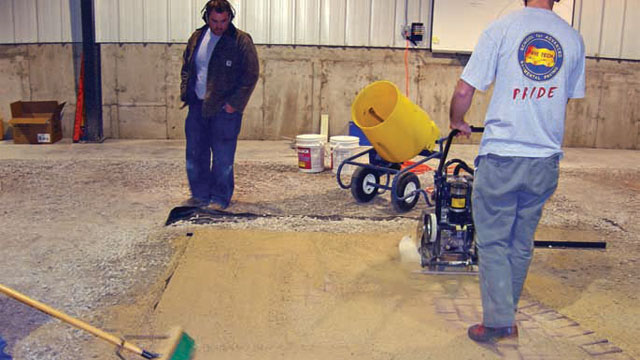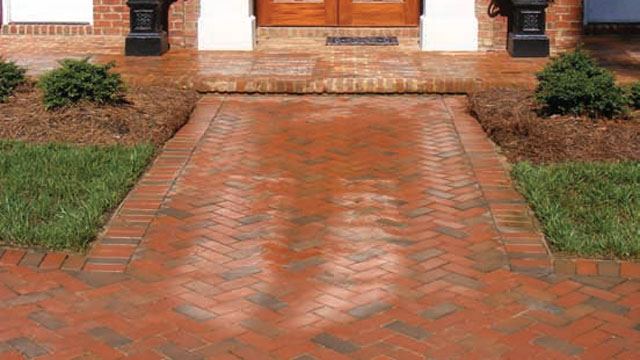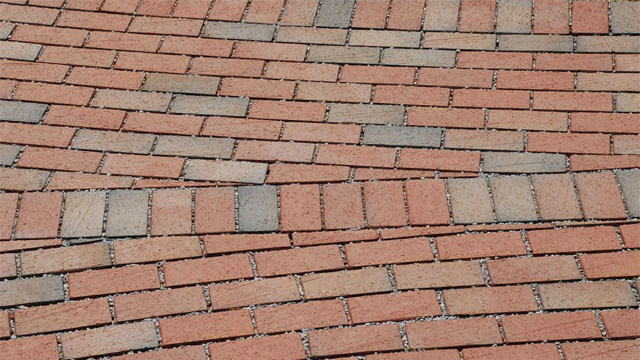April 28, 2011 7:00 AM CDT
Segmental paving is one recession remedy you can consider. Your customer gets a product that’s durable and aesthetically pleasing, and won’t crack, given that you are building the cracks into it. Clay pavers are green and, depending on what you choose, could qualify for LEED credits.
Segmental paving moves with the natural movement of the earth, so it doesn’t break apart like poured concrete can under the pressure of freeze and thaw cycles, and tree roots in search of moisture. If something heaves the pavers up, the cause of the problem can be removed, fixed and the pavers replaced. Segmental pavement also makes it relatively easy to maintain underground utilities. It avoids an unsightly patch that will be there until the entire job is repaved. Best of all, your customer isn’t the only one who gets something out of expanding your business. If you do it right, you’ll get a healthy addition to your bottom line.
If you’re like most, you work with architects and general contractors. As a company that offers paver installation, you can go back to your same Rolodex with a new line that earns you a good profit margin. At the same time, you can reach out to landscaping companies that are now facing an increasing demand for hardscaping.
The Brick Industry Association says that demand is backed up by a recent uptick in the percentages of pavers shipped, from 2.4 percent of all brick products in 2007 to 3.1 percent in 2008, which were the last two years for which figures were available.
What’s the best way to get started? Get some simple, basic training, and keep a simple mission statement in mind: This has to make money.
Too many contractors fall into the trap of having a cash flow focus instead of a profit focus. To earn a profit, you have to figure how to perform a service efficiently and understand how much it is costing you. Doing such things as projecting costs and considering how much of a need there is in your area – the kinds of competition you are facing, etc. – will enhance your chances for success. If you can’t build a business case to go into segmental paving, then don’t.
Unlike many considering embarking on a new business, chances are, you’re not a rookie. You already have a competitive advantage with your brick experience. You may already have done this kind of thing before in your business planning. You probably know more about your town than does a novice. And you probably already have some of the skills and even some of the equipment to expand into segmental paving, like a skid steer to dig out and level, spread aggregates and sand as well as to stage pavers at the laying edge; a brick wet saw for cutting curves and borders. We recommend a plate compactor to complete your equipment short list to go into segmental paving. You can rent one first to determine which one meets your needs.

How about a quick run-through?
In addition to that, there’s new demand and appeal for green construction, including permeable pavers for stormwater retention. Clay pavers are green before they arrive at a jobsite. They are made of the most abundant building material on earth (clay and water), they last virtually forever, and they can be recycled in countless ways.
Permeable clay pavers, like the StormPave and RainPave from Pine Hall Brick Co., are green twice. With a conventional concrete or asphalt surface, certain pollutants (antifreeze, road salts, motor oil, etc.) are washed across the surface after the first inch or so of rainfall, and are then washed into the nearest stream. A permeable surface means that the same water and pollutants will seep into the soil, where it will be naturally filtered.
The best part is that the demand for permeable pavers is growing. The recent survey by the American Society of Landscape Architects of its leading members showed that designs incorporating permeable paving systems that retain or detain stormwater on site are increasingly being specified by property owners and developers.
Using permeable clay pavers can help satisfy state and local stormwater management requirements by recharging the ground water, reducing runoff and, therefore, reducing the volume of stormwater discharge, which reduces erosion downstream. It also allows builders to potentially qualify for LEED credits in four ways, including stormwater design, heat island effect-non roof, use of recycled content and use of regional materials.
Permeable clay pavers appear virtually identical to conventional pavers, except that there’s more of a void area between them. Even so, the void area is less than one-half inch, thus meeting Americans with Disabilities Act requirements for sidewalks.
A second difference can’t be seen: Conventional pavers use a combination of crusher run gravel topped with sand; permeable pavers use open-graded aggregates without fine particles. A #2 stone is used as a sub-base, and then, a finer grade of #57 is used as the base, followed by a bedding layer of #8 or 89 aggregate. The latter also is swept into the joints. Strict adherence to specifier/manufacturer directions must be followed to ensure the system drains properly.

Permeable pavers have additional advantages in both commercial and residential applications. In commercial developments, their use may deem that expensive ditching and a retention pond unnecessary, which opens up more real estate for development. In residential subdivisions, using permeable pavers can help developers meet new requirements that limit the size of impervious areas.
For mason contractors, looking into an alternative but related line of business by adding in segmental paving may make sense, to increase both your business volume and improve your profitability. As the economy recovers, many observers are predicting that future business success will belong to those who decide to take a well-calculated risk and move forward now, so that they will be better positioned when things do improve.
Your best course of action to take when things aren’t looking up is to look down. Instead of brick walls, imagine expansive parking lots, meandering walkways, municipal plazas, dazzling pedestrian malls and home patios.
There’s a whole new market out there for your expertise, so go out there and get it!
Going Horizontal
Considering clay brick pavers
By Ted Corvey

Construction underway - close-up with band.
Bad economy? Business not going up? It may be time to think “horizontal.” Instead of face brick walls, consider clay brick pavers. Visualize parking lots, driveways, sidewalks, patios and pedestrian concourses as far as your eye can see.Segmental paving is one recession remedy you can consider. Your customer gets a product that’s durable and aesthetically pleasing, and won’t crack, given that you are building the cracks into it. Clay pavers are green and, depending on what you choose, could qualify for LEED credits.
Segmental paving moves with the natural movement of the earth, so it doesn’t break apart like poured concrete can under the pressure of freeze and thaw cycles, and tree roots in search of moisture. If something heaves the pavers up, the cause of the problem can be removed, fixed and the pavers replaced. Segmental pavement also makes it relatively easy to maintain underground utilities. It avoids an unsightly patch that will be there until the entire job is repaved. Best of all, your customer isn’t the only one who gets something out of expanding your business. If you do it right, you’ll get a healthy addition to your bottom line.
If you’re like most, you work with architects and general contractors. As a company that offers paver installation, you can go back to your same Rolodex with a new line that earns you a good profit margin. At the same time, you can reach out to landscaping companies that are now facing an increasing demand for hardscaping.
The Brick Industry Association says that demand is backed up by a recent uptick in the percentages of pavers shipped, from 2.4 percent of all brick products in 2007 to 3.1 percent in 2008, which were the last two years for which figures were available.
What’s the best way to get started? Get some simple, basic training, and keep a simple mission statement in mind: This has to make money.
Too many contractors fall into the trap of having a cash flow focus instead of a profit focus. To earn a profit, you have to figure how to perform a service efficiently and understand how much it is costing you. Doing such things as projecting costs and considering how much of a need there is in your area – the kinds of competition you are facing, etc. – will enhance your chances for success. If you can’t build a business case to go into segmental paving, then don’t.
Unlike many considering embarking on a new business, chances are, you’re not a rookie. You already have a competitive advantage with your brick experience. You may already have done this kind of thing before in your business planning. You probably know more about your town than does a novice. And you probably already have some of the skills and even some of the equipment to expand into segmental paving, like a skid steer to dig out and level, spread aggregates and sand as well as to stage pavers at the laying edge; a brick wet saw for cutting curves and borders. We recommend a plate compactor to complete your equipment short list to go into segmental paving. You can rent one first to determine which one meets your needs.

Masons are being trained to install pavers in a patio.
Check with the local technical or vocational school to see if they offer segmental pavement training within an existing masonry or landscaping program. Consider hiring a recent graduate. Or, look into an apprenticeship or other hands-on training for yourself or your employees. For example, the School For Advanced Segmental Training (www.paverschool.com) does an excellent job, as do many of the Interlocking Concrete Pavement Institute programs. Trade shows and manufacturers are other excellent resources. Hardscape North America offers many courses available for attendees (www.HardscapeNA.com).How about a quick run-through?
- Determine the laying pattern. Herringbone is best for vehicular applications.
- Excavate a minimum of 12 inches for vehicular traffic, eight inches for pedestrian. Some projects require an engineer to determine base thickness.
- Proper compaction is essential to the life of an installation, both the sub grade and base layers. A 98 percent compaction is recommended.
- There are different methods of screeding sand. PaveTech’s Sand Screed Pro could be a worthwhile investment to speed the process on larger installs. A simpler method, maybe to begin with, is to lay down two lengths of one-inch metal conduit, parallel to each other and several feet apart. Cover the pipes with concrete sand (ASTM C33), and then use a board across the top of the pipes to screed the sand level. Remove the pipes and use a trowel to fill and smooth the voids.
- Lay the pavers in place and install edge restraints.
In addition to that, there’s new demand and appeal for green construction, including permeable pavers for stormwater retention. Clay pavers are green before they arrive at a jobsite. They are made of the most abundant building material on earth (clay and water), they last virtually forever, and they can be recycled in countless ways.
Permeable clay pavers, like the StormPave and RainPave from Pine Hall Brick Co., are green twice. With a conventional concrete or asphalt surface, certain pollutants (antifreeze, road salts, motor oil, etc.) are washed across the surface after the first inch or so of rainfall, and are then washed into the nearest stream. A permeable surface means that the same water and pollutants will seep into the soil, where it will be naturally filtered.
The best part is that the demand for permeable pavers is growing. The recent survey by the American Society of Landscape Architects of its leading members showed that designs incorporating permeable paving systems that retain or detain stormwater on site are increasingly being specified by property owners and developers.
Using permeable clay pavers can help satisfy state and local stormwater management requirements by recharging the ground water, reducing runoff and, therefore, reducing the volume of stormwater discharge, which reduces erosion downstream. It also allows builders to potentially qualify for LEED credits in four ways, including stormwater design, heat island effect-non roof, use of recycled content and use of regional materials.
Permeable clay pavers appear virtually identical to conventional pavers, except that there’s more of a void area between them. Even so, the void area is less than one-half inch, thus meeting Americans with Disabilities Act requirements for sidewalks.
A second difference can’t be seen: Conventional pavers use a combination of crusher run gravel topped with sand; permeable pavers use open-graded aggregates without fine particles. A #2 stone is used as a sub-base, and then, a finer grade of #57 is used as the base, followed by a bedding layer of #8 or 89 aggregate. The latter also is swept into the joints. Strict adherence to specifier/manufacturer directions must be followed to ensure the system drains properly.

A home featuring a walkway of permeable pavers.
How to Sell It
Knock down the barriers and win the arguments and the sale. To begin, the most oft-repeated criticism of permeable paver storm water management systems is that they clog and become ineffective, which is not true. All stormwater capture systems will clog over time, but permeable pavements will keep as much as 20 percent of their infiltration capacity without maintenance. Still, it’s best not to set it and forget it. Debris will need to be periodically cleaned from the voids by sweeping or vacuuming them off.Permeable pavers have additional advantages in both commercial and residential applications. In commercial developments, their use may deem that expensive ditching and a retention pond unnecessary, which opens up more real estate for development. In residential subdivisions, using permeable pavers can help developers meet new requirements that limit the size of impervious areas.
For mason contractors, looking into an alternative but related line of business by adding in segmental paving may make sense, to increase both your business volume and improve your profitability. As the economy recovers, many observers are predicting that future business success will belong to those who decide to take a well-calculated risk and move forward now, so that they will be better positioned when things do improve.
Your best course of action to take when things aren’t looking up is to look down. Instead of brick walls, imagine expansive parking lots, meandering walkways, municipal plazas, dazzling pedestrian malls and home patios.
There’s a whole new market out there for your expertise, so go out there and get it!
Originally published in Masonry magazine.
About the Author
Ted Corvey is the Vice President of Marketing and Paver Business at Pine Hall Brick Co., Inc. He can be reached at tcorvey@pinehallbrick.com or 800-334-8689.


















